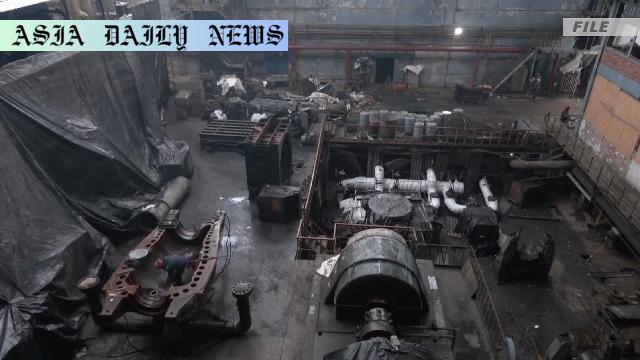Energy Facilities: Russian and Ukrainian officials are accusing each other of attacks on energy infrastructure despite a recent ceasefire.
Energy Facilities targeted amid ceasefire claims.
Russia accuses Ukraine of attacks in Bryansk, Kursk, and Crimea.
Ukraine condemns at least 8 attacks on its energy-related sites.
Both nations previously agreed to halt strikes for 30 days.

The Complex Web of Accusations
In the latest escalation on the heels of an already heightened conflict, Russian and Ukrainian officials have traded accusations over attacks on energy facilities, despite a ceasefire agreement meant to protect these critical infrastructures. The Russian defense ministry claims that Ukraine has used drone technology to target energy-related sites in Russia’s Bryansk and Kursk regions, as well as Crimea, the territory annexed by Russia in 2014. The accusation comes amid a shaky truce involving both nations pledging to refrain from targeting each other’s energy infrastructure.
Meanwhile, Ukrainian officials from the presidential office rebut these claims, asserting that Russia has attacked at least eight energy facilities in Ukraine since March 18. The ongoing incidents renew tensions and raise doubts over the commitment of both sides to uphold the ceasefire. Russian spokesperson Dmitry Peskov confirmed that a moratorium on such attacks remains in place under direct orders from President Vladimir Putin. Similarly, Ukraine agreed to halt strikes on March 19 as part of an effort mediated by the United States.
The Fragile Ceasefire Agreement
The ceasefire on energy infrastructure was established as part of broader efforts to de-escalate the war’s economic and social repercussions. Russia’s agreement, coordinated with the United States on March 18, was aimed at fostering mutual restraint in a pivotal area of the conflict. However, the renewed allegations paint a grim picture of its implementation. Ukrainian representatives argue that these strikes underline Russia’s lack of genuine intent to honor commitments, placing the lives of civilians and the stability of vital infrastructure at continued risk.
For its part, Russia maintains that it has adhered to the terms of the agreement, claiming that Ukraine’s alleged drone strikes represent a breach of faith designed to provoke further escalation. These disagreements magnify an already divided international opinion on who bears primary responsibility for the deteriorating situation. The inability to establish clear accountability complicates future negotiations and broader peace efforts.
Strategic Importance of Energy Sites
Energy facilities play a crucial role in sustaining both nations amidst the ongoing war. Attacks on these infrastructures not only disrupt daily lives but also pose a strategic threat to the economic resilience of the affected regions. For Russia, regions like Bryansk and Kursk are significant due to their proximity to war zones and logistical importance. Simultaneously, for Ukraine, energy sites ensure the provision of power and maintain public morale under extraordinary hardships.
The alleged strikes on Crimea add another layer of geopolitical tensions, as Ukraine contests Russia’s annexation of the territory. As energy becomes a focal point within this broader conflict, the risks of collateral damage and deepened hostilities inevitably increase. With each targeted facility, the war seems to edge further away from diplomacy and more toward devastation, undermining any hopes for meaningful resolution.
What Lies Ahead?
The current situation underscores the fragility of agreements forged in conflict zones. The allegations by both nations not only strain bilateral relations but also complicate avenues for conflict resolution. Trust and accountability, which are already scarce in this conflict, appear to be eroding further. With each new accusation, the prospect of enduring peace diminishes, replaced by an environment rife with suspicion and hostility.
As the 30-day moratorium deadline approaches, international actors, including the United States, will likely face increased pressure to intervene as mediators. The challenges, however, resonate beyond diplomacy. Both countries must recognize that targeting energy structures reflects a dangerous trend: one where civilian hardships are amplified to gain military advantage. Avoiding this slippery slope is essential to preserving not just lives, but also the prospect of eventual recovery and reconciliation.
Commentary
The Growing Crisis of Energy Facility Attacks
The escalating conflict between Russia and Ukraine continues to defy ceasefire attempts, with energy facilities emerging as a focal point in this ongoing war. These latest accusations from both sides regarding attacks on energy-related infrastructure are deeply concerning, given their critical importance to civilians’ daily lives and the broader economic stability of both nations. This pattern of targeting energy facilities betrays not only a tactical strategy but also a troubling disregard for the humanitarian implications of such actions.
The Fragility of Agreements
What stands out in this situation is the stark inability of both Russia and Ukraine to adhere to their commitments under the 30-day ceasefire agreement. While it is true that trust between the two countries has eroded significantly due to years of animosity and war, these recent allegations further highlight how fragile even mediated agreements are. This raises questions about the effectiveness of international interventions and whether stronger measures are needed to enforce compliance.
The Path Forward
Looking ahead, neutrality and international oversight could be crucial to de-escalating tensions surrounding these energy facility attacks. Maintaining a neutral stance on such critical matters may pave the way for parties involved to view one another not just as adversaries but as stakeholders in peace. Moreover, targeted energy facilities are not just functional assets; their destruction threatens the very fabric of societal survival in both nations. Protecting them should take precedence over any military objectives.
Ultimately, there must be a renewed focus on fostering dialogue rather than perpetuating violence. It is essential for both Russia and Ukraine to step back and reconsider the long-term implications of their actions, not just for their own people, but for the region’s overall stability. Diplomacy remains the best solution to avoid spiraling further into chaos.


